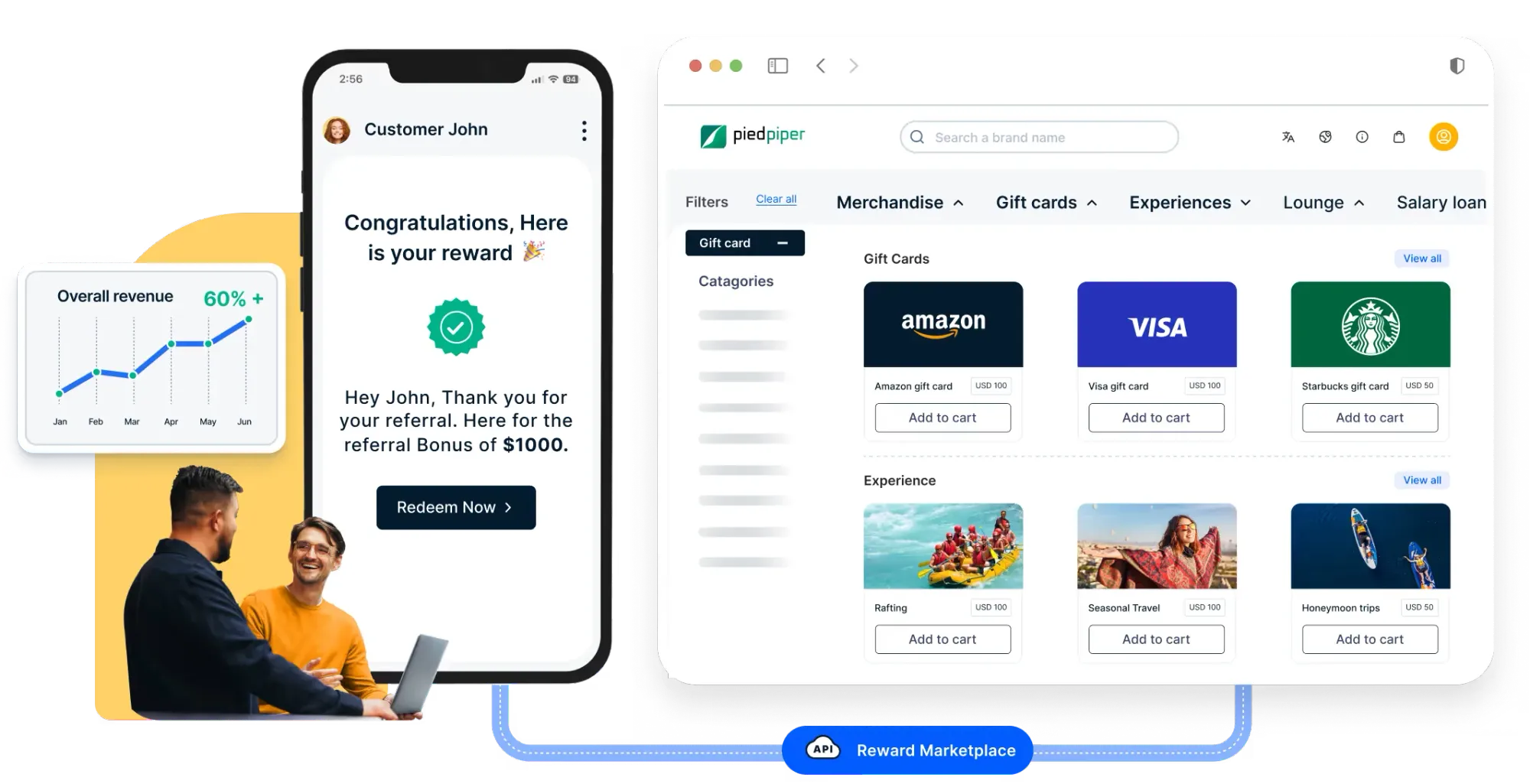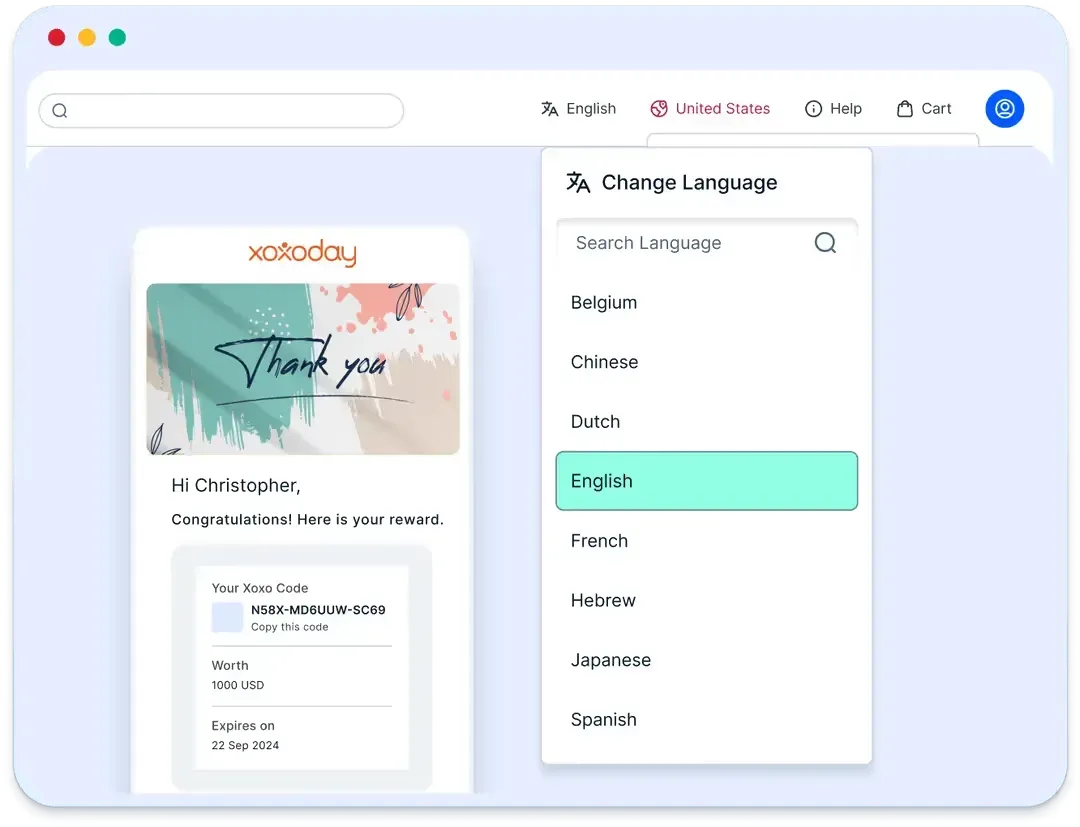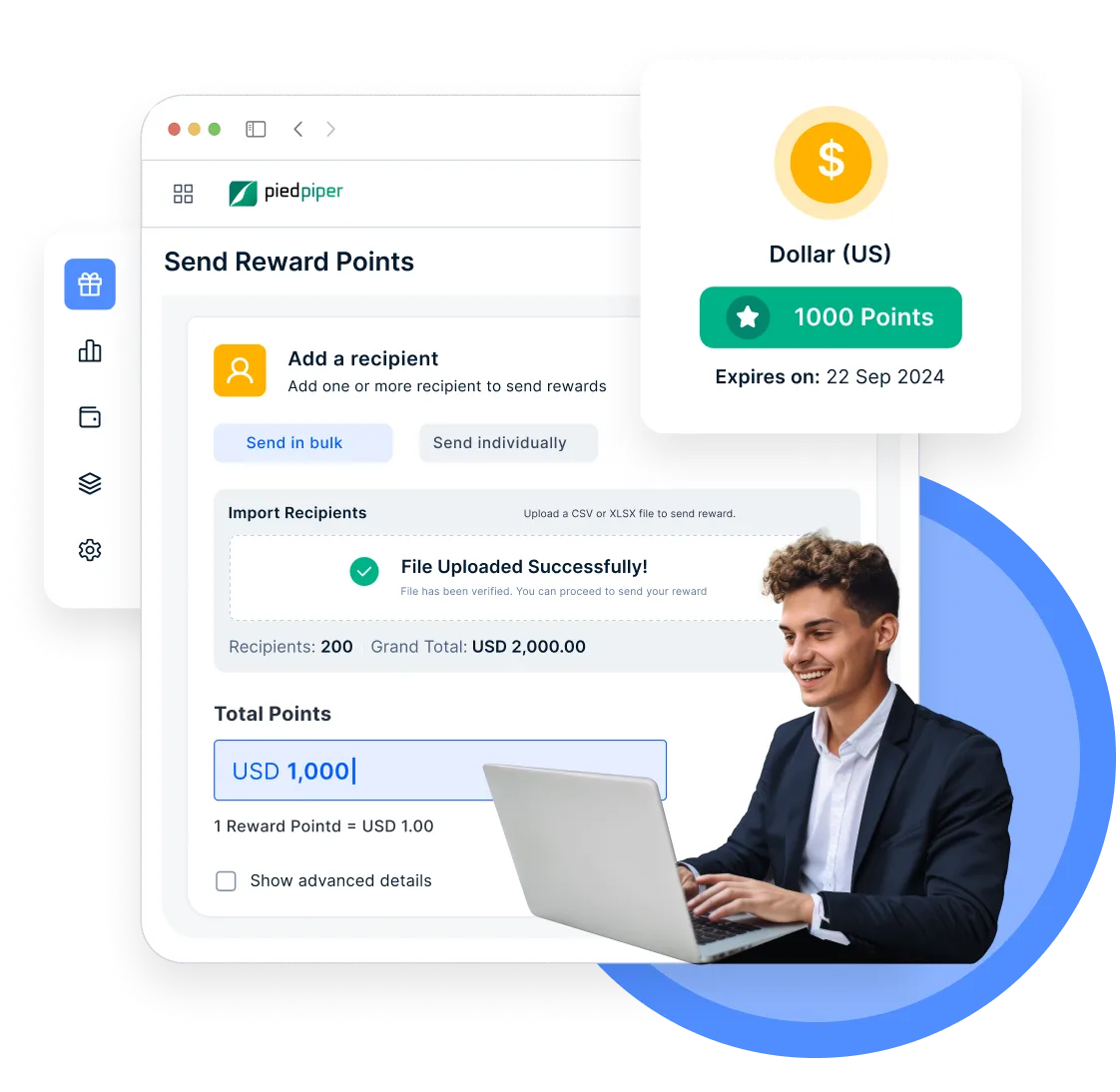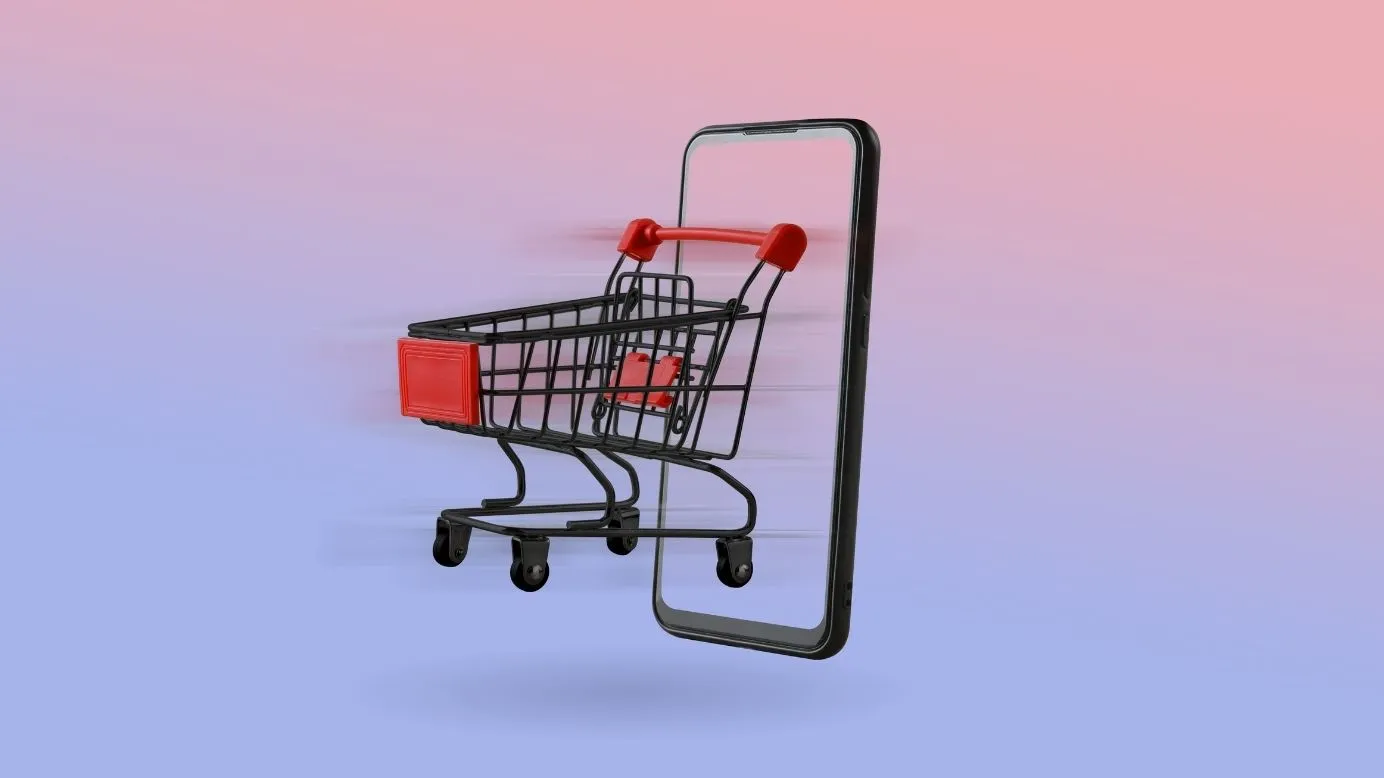What is reward marketing and how to use it for customer acquisition, loyalty and retention
Reward marketing is one of the most effective ways to engage your customers. This blog will talk more on how to use reward marketing and how it can help you.
On this page
- What is reward marketing?
- How can a reward program help in reward marketing?
- How does reward marketing help you across the marketing funnel?
- Types of Reward Marketing Programs
- How to choose the right rewards for reward marketing
- Tips for building a successful customer reward program
- Unlock the power of reward marketing with plum
Reward programs in marketing works and we don’t have to look very far behind, to find the evidence. A recent study found out that 82.4% of customers tend to shop more from stores that have some form of reward program. This goes on to prove the effectiveness why use reward marketing and how it can help you in edging out the competition. This blog attempts to dig deep and find out the inner workings of the marketing strategy in question - What is reward marketing and how it can help?
What is reward marketing?
Reward marketing is the strategic use of incentives to drive valuable actions from a target audience—whether customers, affiliates, influencers, or employees. These actions can range from making a purchase, subscribing, and referring friends to leaving reviews or sharing content.
The idea is simple: offer a compelling reward to encourage behavior that benefits the brand, often more cost-effectively than traditional paid marketing methods.
How can a reward program help in reward marketing?
Reward program has a vast scope as it can be used to create better engagement with - employees via employee rewards, channel partners, and customers via different reward and loyalty programs (anything to do with building a human relationship).
A reward program acts as the engine that powers reward marketing by creating structured, repeatable, and measurable ways to incentivize customer behavior. Instead of offering one-off discounts or random perks, a reward program allows brands to systematically encourage actions that align with their business goals—like signing up, making repeat purchases, or referring friends.
When applied in marketing, rewards can help you -
- Build connections
- Increase customer loyalty
- Deepen engagement and
- Attract new customers

Reward marketing is a practice where you leverage a reward or loyalty program through program participation. This is done by providing appealing and attractive rewards.
How does reward marketing help you across the marketing funnel?
Acquisition:
Customer acquisition is essential for businesses of any age and size. Being able to attract and convert new customers systematically, keeps companies healthy and growing — and investors happy. But how do you do that?
Consider reward marketing. Reward marketing helps you provide that extra something - be it incentives, credits, physical gifts, monetary rewards or even non-monetary rewards to your customers. The best thing about reward marketing is its multi-purpose properties. Reward marketing is not just a one-way funnel but a flywheel that helps you acquire the right kind of customers who will stick around.
Retention:
Building a new customer base is expensive. The costs may vary across industries. But according to Mehdi Khosrow-Pour in his book "Emerging Trends and Challenges in Information Technology Management," replacing a customer is five times more costly than keeping an old one.

Emerging Trends and Challenges in Information Technology
A better approach is to keep the customers you have, by opting for customer incentives or smart reward marketing programs. This will help you in retaining customers and making them loyal towards your brand. Knowing that making a second purchase from your brand will earn customers coupon codes/vouchers will make your product more attractive than those of your competitors.
Referrals:
Another benefit of reward marketing is that it can help you tip a potential customer to make a purchase – especially when backed up by a friend's recommendation. Referral rewards come in all shapes and sizes, but the trick is offering ones that complement your brand experience and meet your customers' needs. The most common ways are -
- Rewarding both parties with coupon codes redeemable at next purchase.
- Rewarding the recommender with bonus points.
- Getting creative with free products.
Customer advocacy:
Customer Advocacy is a way that allows brands to acquire new and valuable customers organically. The positive attitude of the customers towards your brand's products/services and leads them to recommend the same to others after experiencing it themselves.
Your customer advocates are driven by something called - SAPS (Status, Access, Power or Stuff), and reward marketing can do that. You see, reward marketing is not only about giving coupons and freebies but creating an ecosystem where customers can share knowledge, expertise and making customers feel that their opinion matters.
Types of Reward Marketing Programs
Reward marketing is a versatile strategy that enhances customer engagement, acquisition, and advocacy. Whether used to attract new customers, incentivize referrals, or strengthen brand loyalty, reward programs can drive meaningful actions and create long-term value. Here are some key types of reward marketing programs:
1. Referral programs
Referral marketing transforms satisfied customers into brand advocates, encouraging them to share your brand with friends, family, and colleagues. This word-of-mouth strategy leverages referral links, codes, and gamification to make sharing effortless and rewarding.

Participants typically receive incentives such as discounts, credits, or cash rewards when their referrals complete a desired action—such as signing up, making a purchase, or requesting a quote. Some businesses, like insurance companies, structure multi-stage rewards, offering an initial incentive for generating leads and another upon conversion.
2. Reward-based customer acquisition campaigns
Brands increasingly use financial incentives to attract new customers, such as:
"Sign up today and receive a $50 reward!" or "Switch your account and get $200 cash!"
These campaigns often offer cash, gift cards, or vouchers that appeal to consumers without diminishing the perceived value of the product—unlike traditional discounting strategies. Businesses may deploy these promotions through digital ads, QR codes, or limited-time campaigns across different customer acquisition channels.
3. Partnership marketing
Beyond customer referrals, partnerships with affiliates, influencers, and other brands can create a high-impact marketing channel. By leveraging trusted partners, businesses can extend their reach while maintaining control over brand messaging and performance-based incentives.
Partners can use similar reward structures—discounts, exclusive gifts, or cashback—to drive customer actions, making partnership marketing an efficient and scalable method for customer acquisition.
4. Customer advocacy programs
Encouraging customers to leave reviews, share testimonials, or generate content about your brand enhances credibility and trust. Given that over 70% of consumers check online reviews before purchasing, an active advocacy program can significantly boost conversions.

Incentivizing customers with rewards for leaving genuine reviews, posting product images, or sharing experiences on social media increases participation. However, brands should ensure transparency and compliance with review policies to maintain authenticity.
5. Community engagement and customer support incentives
Some brands harness the power of their communities to provide customer support and engagement. GiffGaff, for instance, rewards users who help answer technical questions and support other customers in forums.
By gamifying community participation—offering points, exclusive perks, or premium memberships—businesses can turn loyal customers into valuable brand contributors, fostering collaboration and reducing operational costs.

6. Employee referral programs
Your employees can be powerful advocates for your brand. Employee referral programs reward team members for introducing your products or services to their personal networks.
For example, employees may receive bonuses or perks when their referrals subscribe to a service or make a purchase. This not only drives sales but also enhances employee engagement by giving them an opportunity to share valuable deals with their friends and family.
7. Employee perks and recognition programs
Just as customer loyalty is vital, retaining and motivating employees is equally crucial. Reward programs designed for employees can boost morale, performance, and long-term commitment.
Companies can offer monetary bonuses, extra vacation days, personalized perks, or exclusive experiences to recognize outstanding contributions. Investing in employee rewards fosters a culture of appreciation and enhances overall workplace satisfaction.
8. Point-based system
This is a kind of reward program that lets customers collect points that can be redeemed on various products/services. They are much easier to set up, making it the most popular type of customer retention program.
Many e-commerce businesses who struggle to get customers in the virtual door might find a solution in this kind of loyalty program. There are various ways the customer can earn such points. For example - social sharing, grievance compensation, emails, or any other actions you take to drive traffic to your site.
9. Frequent buyer program
It is an excellent tool for maintaining brand loyalty. It's generally in the form of a gift card, voucher, discounts, freebies, or special customer treatment. It is usually given to customers who come to your site or store and hit "purchase" more frequently.
It is an easy and commonly used customer retention program for both technical (Amazon, Victoria Secrets) and non-technically advanced (coffee shops, gas stations) businesses.
10. Gamification
Gamification is not a new tactic in the marketing field. Companies have been creating experiences of a game in a non-game environment to increase sales. Gamification will always be relevant because it plays on people's natural competitive instincts, to trigger action and influence buyer choices.
This type of program can be used for both customer acquisition and retention. There are different elements to gamification, and each drives a different result -
- Redeemable reward points provide feedback that feeds the customer's need for instant gratification.
- Badges are like visual status symbols. They influence behaviour that triggers the customer to engage with your brand more, to earn more badges.
- Milestones reveal the success journey of the customer with your brand. They inspire a sense of achievement and more competition.
- Avatars can be used for creating a narrative context. They allow customers to become part of a community, which triggers more interest.
11. Contest/Sweepstakes
Contest/sweepstakes are designed to fulfil the human need to win. A win is of no use if there is no reward. However, the way of determining the win is different for both contests and sweepstakes. In sweepstakes winners are chosen by luck.
The prizes can range anything from - stickers, t-shirts, houses, cars, and enormous cash wins. They are a great way of acquiring new customers. Contests, on the other hand, draw winners based on some merit. In such cases, the prize is also something that gains the interest and motivates customers to enter the contest. This is a useful tool for retaining customers who are already part of your target base. Contest and sweepstakes together are a force to be reckoned. They not only generate interest but also help in expanding your reach to a larger target audience.
12. Product reviews
The e-commerce sector commonly uses this kind of reward marketing. Customers can rate and comment on products they have purchased on the product page. Other consumers can read remarks when making a purchase decision. However, nudging customers to share their positive feedback is not easy.
What’s in it for them?
It is a win-win situation because –
- It leads to increased traffic, as customers come back to redeem their points.
- Their ratings and reviews help new customers in making the crucial decision of purchase.
How to choose the right rewards for reward marketing
Selecting the right rewards is critical to ensuring the success of any reward marketing initiative. Whether you're focused on acquiring new customers, encouraging loyalty, or boosting retention, your reward strategy must align with the audience's preferences, the desired action, and your brand identity.
Here’s a comprehensive framework to help you make the right choices:
1. Define the objective of the reward campaign
Start by identifying what action you want your audience to take. The type of reward you offer should directly align with your marketing goal.
- For customer acquisition: Choose rewards that spark immediate interest and drive first-time conversions. For example, a $10 Starbucks e-gift card for new users who complete a sign-up or download your app.
- For retention: Focus on incentives that build habits and encourage repeat usage. Think of a $25 subscription credit after the third monthly order.
- For loyalty: Offer high-value, status-driven perks that deepen brand affinity, such as access to premium experience or exclusive early access to product drops.
2. Understand your audience
Choose rewards that reflect your audience’s lifestyle, values, and behaviors. One of the biggest mistakes in reward marketing is assuming all customers are motivated by the same thing.
- For urban millennials or Gen Z: Popular digital rewards like Netflix, Uber Eats, or DoorDash gift cards appeal to their convenience-driven lifestyle.
- For professionals: Health and productivity rewards such as Headspace subscriptions, Audible credits, or Apple gift cards work well.
- For socially conscious consumers: Allow them to convert points into charity donations (e.g., through platforms like DonorsChoose or Feeding America).
Conduct surveys, analyze buyer personas, or tap into demographic data to understand what motivates your target audience.
3. Match reward value to the action taken
The value of the reward should be proportional to the user’s effort or commitment. If the action requires more time or money from the customer, the reward should reflect that.
- Low-effort action (e.g., email sign-up): Offer low-cost but meaningful micro-rewards such as a $5 Dunkin’ e-gift card.
- High-effort action (e.g., subscription or purchase): Use higher-value incentives like a $50 Best Buy gift card or branded merchandise bundle.
This approach ensures the reward feels appropriate and worthwhile, increasing the likelihood of conversion.
4. Offer personalization and choice
Letting customers choose their rewards increases satisfaction and engagement. A one-size-fits-all approach rarely works, especially with diverse customer bases.
- Provide access to a digital rewards catalog with broad options—retail (Target, Walmart), dining (Chipotle, Grubhub), travel (Delta Airlines, Airbnb), or wellness (ClassPass, Calm).
- Use segmentation to tailor rewards to different customer personas—new moms, frequent travelers, tech enthusiasts, and more.
Personalized rewards make your brand feel more human and increase emotional connection.
5. Ensure ease of delivery and redemption
The best rewards are those that are instantly accessible, easy to use, and don’t require jumping through hoops. A complicated redemption process can kill customer excitement and dilute campaign results.
- Opt for digital rewards over physical ones to eliminate delays and shipping hassles.
- Use link-based or email-delivered gift cards from platforms like Xoxoday Plum to ensure real-time gratification.
For example, brands like Dropbox and Instacart use instant rewards for referrals, keeping the process seamless and satisfying.
6. Align rewards with your brand identity
Your reward is a brand touchpoint. It should reinforce your brand personality, tone, and promise. A reward that feels out of sync with your brand can confuse or alienate your audience.
- If you’re a luxury lifestyle brand: Offer premium experiences like spa packages, exclusive merchandise, or fine dining experiences.
- If you’re a tech-forward brand: Offer gadget-friendly rewards like Amazon Echo devices or Logitech accessories.
- If sustainability is core to your brand: Include carbon-offset credits or donations to environmental organizations like The Nature Conservancy.
The key is to use your rewards to strengthen the narrative your brand is already telling.
Tips for building a successful customer reward program
A perfectly running reward program should be rewarding, engaging, and motivating. Here are some tips to consider while running a reward marketing program :
- Make rewards appealing: Customers may sign up for your rewards program, but it doesn’t always equate to loyalty. Did you know? Only 13% of customers are complete loyalists. Therefore, your rewards program has to be appealing and enticing enough for customers to sign up and use it regularly. For example, many high-end beauty salons charge members a fee to join but also offer seasonal and monthly coupons of the same amount to offset the cost of the program.
- Make the reward program easy to understand: One of the most complicated parts of launching a customer reward program is explaining it to customers. If your plan is too confusing, or time-consuming, your customers won’t sign up. Here, minimalism is the key. While explaining your program, keep the language simple and keep the description small (one or two sentences), and don’t forget to mention what is in it for them.
- Rewards need to be relevant: Rewards create loyalty only if your company knows how to share value. Which means you need to give customers rewards that are relevant and valuable for them. The best way to do that is by creating different tiers. Segment your customers based on where, when and how they shop and reward them accordingly.
Unlock the power of reward marketing with plum
Reward marketing isn't just a tactic—it’s a game-changer for customer acquisition, retention, and advocacy. By implementing referral programs, loyalty incentives, and gamified experiences, businesses can create meaningful engagement that turns casual buyers into lifelong customers.
However, managing a reward program at scale requires the right infrastructure. Plum simplifies the process by offering:
- A vast global reward catalog – Digital gift cards, experiences, cashback, and more.
- Automated reward distribution – Set triggers for instant and seamless delivery.
- Flexible redemption options – Let customers choose rewards that resonate with them.
- Seamless integration – Easily connect with your CRM, e-commerce, or loyalty platform.
Make your reward marketing strategy effortless and impactful. Boost conversions, retain customers, and create lasting brand loyalty with Plum.
Ready to elevate your reward marketing game? Book a demo with Plum today!


















